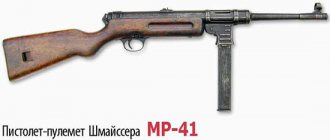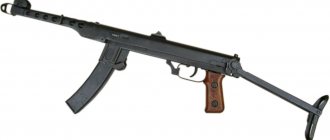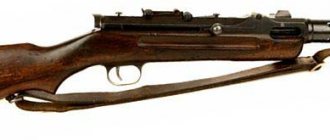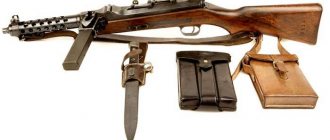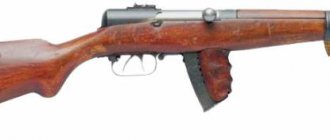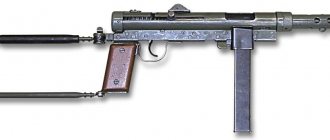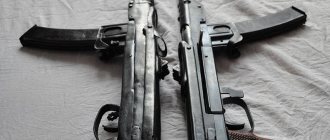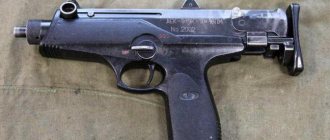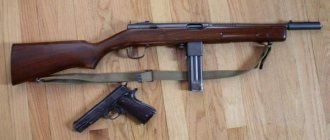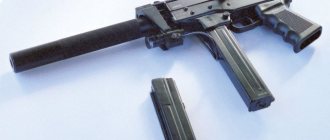Submachine gun MGD / ERMA PM-9 (France)
MGD submachine gun caliber 7.65x20 (presumably a prototype).
9mm caliber MGDPM-9 submachine gun, right view.
9mm caliber MGDPM-9 submachine gun, left view.
MGDPM-9 submachine gun, 9mm caliber, folded.
View of the MGDPM-9 receiver, with rotating cocking handle and folding magazine receiver.
The author demonstrates the compact dimensions of the MGD PM-9 submachine gun in the folded position.
Diagram from the original patent for the design of the MGD submachine gun.
Characteristics
| Caliber | 9x19mm Luger/Parabellum |
| Weight | 2.53 kg |
| Length (butt folded/opened) | 359 / 659 mm |
| Barrel length | 213 mm |
| Rate of fire | 750 rounds per minute |
| Magazine capacity | 32 rounds |
| Effective range | 100 meters |
The MGD submachine gun was developed in the late 1940s by the Frenchman Louis Debuit, who worked for the French company Etablissements Merlin & Gerin. Apparently, the original main goal was to create the most compact weapons suitable for concealed carry. The first prototypes were chambered for the French 7.65x20mm cartridge; later development was carried out for the 9x19 cartridge. Small-scale production was launched in France in the period 1954-55, with both standard submachine gun variants (with a short barrel and folding stock) and “carbine” variants, with a long barrel and awkward wooden stock, being offered. However, the high complexity in production determined the high cost of the MGD PM-9 submachine gun, and its production was quickly curtailed. In 1956, the famous German company Erma Werke tried to launch the production of MGD PM-9 submachine guns, but everything was limited to an installation series of 10 units, after which Erma switched to other developments.
The MGD PM-9 submachine gun used a semi-blowback automatic; slowing down the opening of the shutter was carried out due to the interaction of a lightweight shutter and a rotating flywheel associated with a spiral return spring. During the process of rolling back the bolt, the flywheel rotated approximately 180° back, and then in the opposite direction, returning the bolt forward and sending a new cartridge into the barrel. Shooting was carried out from an open bolt, the fire modes were single shots and automatic fire. The safety switch is located on the left side of the receiver, above the trigger guard. The bolt cocking handle is located on the right, and to cock the weapon it is rotated up and back. The butt is metal, folding to the side. The magazine receiver also folds forward; standard magazines from German MP.38 and MP.40 submachine guns are used.
History[edit]
In the early 1920s, Vollmer began developing his own submachine guns. Its early models, called VPG, VPGa, VPF and VMP1925, were quite similar to the MP18. The VMP1925 had a wooden handle and was fed from a 25-round drum magazine. The VMP1925 was secretly tested by the Reichswehr along with competing designs from Schmeisser and Rheinmetall. (The Treaty of Versailles prohibited the Reichswehr from carrying submachine guns, although German police were allowed to carry a small number). Vollmer was given secret funding to continue development, and this led to the creation of the VMP1926, which differed mainly from its predecessor by removing the cooling jacket. The next development was the VMP1928, which used a 32-round box magazine protruding from the left side. The latest development in this series was the VMP1930. (It can also be seen on WTS.) This model introduced a significant innovation - a telescoping mainspring assembly, which made the pistol more reliable and easier to assemble and disassemble in the field. Vollemer applied for a patent for his innovation in 1930, and in 1933 he received the patent under DRP No. 580620. However, his company, Vollmer Werke, only produced about 400 of them, and most of them were sold to Bulgaria. At the end of 1930, the Reichswehr stopped financial support for Vollmer; as a result, he sold the rights to all his designs to a company known as Erma Werke (which is an abbreviation for ErfurterMaschinenfabrik, Berthold Geipel GmbH). [2]
The submachine guns that Erma began selling in 1932 under the names EMP (Erma Maschinenpistole) or MPE (Maschinenpistole Erma) were basically just VMP1930s with a remanufactured cooling jacket. Although there were several variants with different barrel lengths and sights made to suit customer requirements, approximately three main variants were produced: one with a 30 cm barrel, a tangent rear sight and a bayonet-stalk tip was sold to Bulgaria or Yugoslavia. The second model, sometimes called the MP34 or "standard model", had a 25 cm barrel and no bayonet; The rear sight on them varies - some had a tangent sight, others had a simplified flip-up L-shaped sight. The third option was basically similar in metal parts, but replaced the handguard with an MP18 type stock with finger grooves. In total, at least 10,000 of these Vollmer-based designs were made by Erma. [2] They were accepted by the SS and German police, but were also sold to Mexico, Yugoslavia and Spain. [3] During the Spanish Civil War, the EMP was used by both Republicans [4] and Nationalists. [5]
In the spring of 1939, large numbers of defeated Spanish Republicans fled to France, where they were disarmed. About 3,250 EMPs previously in the possession of these fighters ended up in a French warehouse in Clermont-Ferrand. In French documents, the EMP was usually referred to as "Erma-Vollmer". The French tested the weapon and decided to adopt it. A preliminary manual was printed in French under the title Provisoire sur le pistolet-mitrailleur Erma - Vollmer de 9mm
, issued December 26, 1939 and updated January 6, 1940.
However, the French only received about 1,540 suitable magazines for these guns, so only 700-800 EMPs were actually issued to French troops, mainly the Gendarmerie Mobile. After the Germans conquered France, some EMPs armed the Legion of French Volunteers against Bolshevism, which eventually eventually became part of the SS division "Charlemagne". This division was virtually destroyed in February 1945 in East Prussia, now part of Poland. Numerous EMPs were discovered on the final battlefields of the SS Charlemagne Division; Most of these guns do not have German military stamps or hallmarks. [6] EMPs that arrived in German hands via the French route were designated ( Fremdgerät
) 740(f). [7] Yugoslav purchased EMPs were used by both Partisans and Chetniks. [8]
In Franco's Spain, EMPs chambered in 9mm Largo were produced locally until the mid-1950s. It was designated Model 1941/44 [9] or "subfusil Coruña". [10] It performed poorly during the Ifni War. [eleven]
Description
The Bergmann submachine guns models 34 and 35 were developed by designer Emil Bergmann based on the old technical documentation of the MP18; in appearance they were similar to the Schmeisser samples, but differed from them not only in the right-hand location of the magazine, but also in a number of design features.
The MP.35 submachine gun is equipped with a blowback system and fires from an open bolt. A distinctive feature of the weapon is the cocking handle; it is located at the rear end of the receiver and repeats the cocking of the bolt of a Mauser rifle. When firing, the bolt handle is motionless. The fuse was on the left side of the receiver. Fire modes: single shots or automatic fire. The weapon had a front sight and a sector rear sight, marked from 100 to 500 meters. Partial pressing of the trigger gave a single shot, and a full press gave automatic fire.
Influence
Based on the EMP-35, Erma developed the EMP 36 submachine gun. This can be considered an intermediate model between the EMP-35 and MP38. Although many parts of the mechanism were changed from the EMP-35, it kept the Vollmer telescopic guide tube largely unchanged. Externally, the most obvious differences are that the magazine was now mounted almost vertically, as it was tilted slightly to the left and forward. The massive wooden stock was replaced by a wooden frame and a folding metal stock. It is not entirely clear who developed the EMP 36, although the name Berthold Geipel is usually given. Apparently, the features of the new design were the result of another secret contract with the German army.[3]
